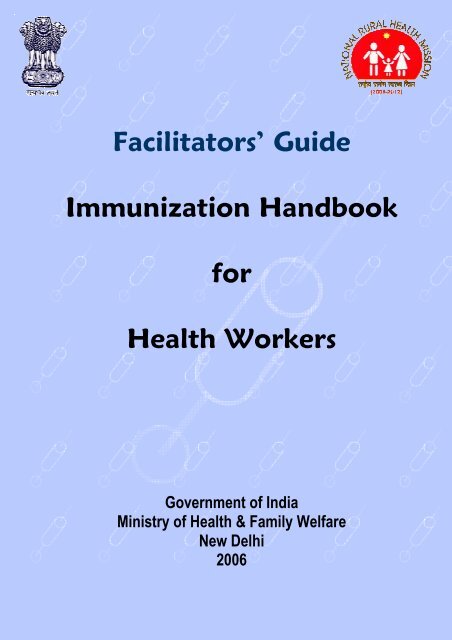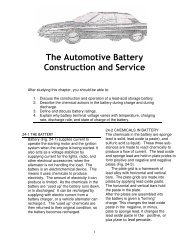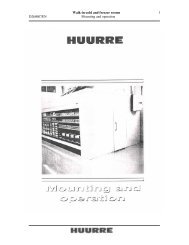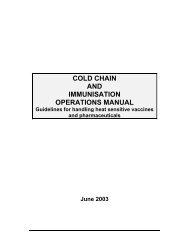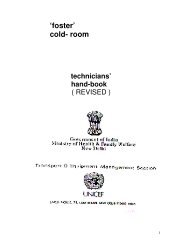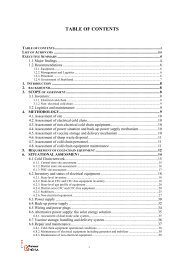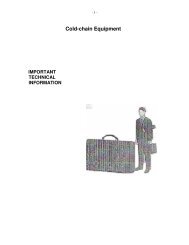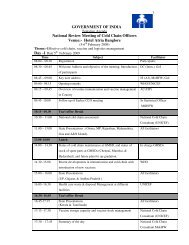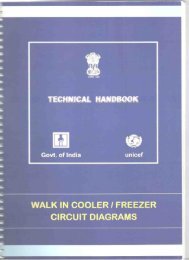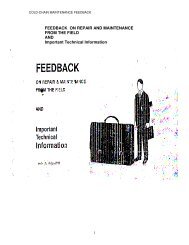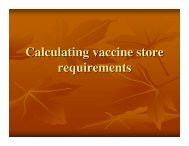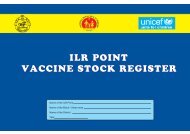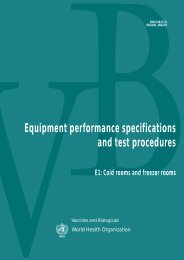Facilitators' Guide Immunization Handbook for Health ... - Nccvmtc.org
Facilitators' Guide Immunization Handbook for Health ... - Nccvmtc.org
Facilitators' Guide Immunization Handbook for Health ... - Nccvmtc.org
You also want an ePaper? Increase the reach of your titles
YUMPU automatically turns print PDFs into web optimized ePapers that Google loves.
Facilitators’ <strong>Guide</strong><br />
<strong>Immunization</strong> <strong>Handbook</strong><br />
<strong>for</strong><br />
<strong>Health</strong> Workers<br />
Government of India<br />
Ministry of <strong>Health</strong> & Family Welfare<br />
New Delhi<br />
2006<br />
1
Published by:<br />
Copyright:<br />
Address:<br />
Email:<br />
Web:<br />
Department of <strong>Health</strong> and Family Welfare,<br />
Government of India<br />
Ministry of <strong>Health</strong> and Family Welfare<br />
Government of India, 2006<br />
Nirman Bhawan,<br />
Maulana Azad Road,<br />
New Delhi, 110011, India<br />
polioindia@yahoo.com<br />
www.mohfw.nic.in<br />
Your suggestions <strong>for</strong> improving or enhancing the Facilitators’ <strong>Guide</strong> <strong>for</strong> the <strong>Immunization</strong><br />
<strong>Handbook</strong> <strong>for</strong> <strong>Health</strong> Workers are always welcome and encouraged.<br />
2
Table of Contents<br />
1.0. Introduction .......................................................................................................................4<br />
2.0. Suggested guidelines <strong>for</strong> immunization training of health workers.......................................4<br />
3.0 Pre-training preparation check-list .......................................................................................4<br />
4.0. Tentative Programme <strong>for</strong> <strong>Immunization</strong> Training of <strong>Health</strong> Workers ..................................6<br />
5.0. List of Equipment and Supplies required during training ......................................................7<br />
6.0. Conducting Training Sessions ..............................................................................................8<br />
7.0. Post Training Activities......................................................................................................13<br />
Handout 1: Pre and post test Questionnaire..................................................................14<br />
Handout 2: VPD Quiz...................................................................................................16<br />
Handout 3: National <strong>Immunization</strong> Schedule <strong>for</strong> Children and Pregnant Women .........17<br />
Handout 4: Sub-center Session Plan and Workplan .......................................................18<br />
Handout 5: Vaccine Sensitivities ....................................................................................19<br />
Handout 6: Tally Sheets ................................................................................................20<br />
Handout 7: Monitoring Chart.......................................................................................21<br />
Handout 8: Feedback from Participants Form ...............................................................22<br />
Annex 1: Answers to Pre and Post Test Questionnaire (with scores) ...............................24<br />
Annex 2: Registration Form <strong>for</strong> Participants ..................................................................26<br />
Annex 3: Temperature Chart.........................................................................................27<br />
Annex 4: Shake Test ......................................................................................................28<br />
Annex 5: Role Play Scripts .............................................................................................29<br />
Annex 6: UIP Reporting Formats...................................................................................31<br />
Annex 7: Sample Certificate...........................................................................................32<br />
Annex 8: Training Workshop Reporting Format............................................................33<br />
Annex 9: Checklist <strong>for</strong> monitoring Quality of <strong>Immunization</strong> Training ............................34<br />
Annex 10: Checklist <strong>for</strong> Follow up (On-the-Job) Evaluation of <strong>Health</strong> Workers after<br />
<strong>Immunization</strong> Training ....................................................................................36<br />
3
1.0. Introduction<br />
The Facilitator’s guide is meant to accompany the <strong>Immunization</strong> <strong>Handbook</strong> <strong>for</strong> imparting<br />
immunization training to health workers. The training aims to improve the knowledge and<br />
skills of health workers in providing better immunization services to the community.<br />
The facilitator must read through the <strong>Immunization</strong> <strong>Handbook</strong> and the Facilitator’s <strong>Guide</strong> in<br />
great detail be<strong>for</strong>e conducting the training. This will help in making your job easier as a<br />
trainer and improve the quality of training.<br />
2.0. Suggested guidelines <strong>for</strong> immunization training of health<br />
workers<br />
Duration of training<br />
No. of trainees per<br />
batch<br />
Venue<br />
Trainers<br />
No. of trainers<br />
Methodology<br />
2 working days<br />
12-15<br />
District Hospital and ANM Training Center (ANMTC)/ First Referral<br />
Unit/ Community <strong>Health</strong> Center (CHC)<br />
District <strong>Immunization</strong> Officer /ANMTC trainer / Pediatrician/ CHC<br />
Medical Officer<br />
1 facilitator <strong>for</strong> each group of 4-5 trainees<br />
Group discussions, Exercises, Demonstration and Return<br />
Demonstration, Hands-on-practice, Role play, Field Visit, Film<br />
show<br />
3.0 Pre-training preparation check-list<br />
1. Finalize the venue <strong>for</strong> training and date and time allocation <strong>for</strong> various sections of the<br />
training workshop.<br />
2. Depute personnel who will assist in the training workshop.<br />
3. Identify sites <strong>for</strong> field visit <strong>for</strong> skill training and liaise with concerned officials to get their<br />
confirmation.<br />
4. Confirm nomination of participants.<br />
5. Ask participants to bring along their sub-center’s population and immunization data <strong>for</strong><br />
preparing micro plan and monitoring charts<br />
6. Arrange <strong>for</strong> teaching aids like blackboard, chalk, Flip charts, OHP, transparencies and<br />
markers, TV & CD player, etc. <strong>for</strong> various sessions.<br />
4
7. Arrange <strong>for</strong> participants’ stationery including adequate numbers of folders,<br />
<strong>Immunization</strong> <strong>Handbook</strong>s, handouts and any other training materials.<br />
8. Prepare Skill assessment checklist.<br />
9. Print Participants’ Certificates.<br />
10. Arrange requisite number of TA/DA <strong>for</strong>ms, background documents, registration <strong>for</strong>ms<br />
etc.<br />
11. Arrange <strong>for</strong> accommodation, transportation, payment of honorarium, TA/DA and <strong>for</strong><br />
refreshment and lunch during the workshop.<br />
12. Finalize programme <strong>for</strong> inaugural and valedictory sessions.<br />
5
4.0. Tentative Programme <strong>for</strong> <strong>Immunization</strong> Training of<br />
<strong>Health</strong> Workers<br />
Day-I<br />
09.00 – 09.30 Registration<br />
09.30 – 10.15 Inauguration, Expectations of the participants and Pre<br />
testing<br />
10.15-10.45 Introduction and <strong>for</strong>mation of groups of 4-5 participants Unit -1<br />
with one facilitator each<br />
10.45 – 11.30 Briefing on VPDs and Vaccines followed by film. Unit-2<br />
11.30 – 11.45 Tea<br />
11.45 -12.30 Quiz on filling of National <strong>Immunization</strong> Schedule in Unit -3<br />
groups<br />
12.30 – 13.30 Lunch<br />
13.30– 15.30 • Discussion on microplan <strong>for</strong> immunization Unit -6<br />
• Preparation of microplan (exercise).<br />
• Conducting immunization session and<br />
educating parents (role play)<br />
15.30 – 15.45 Tea<br />
15.45 – 17.15 Briefing on cold chain and injection safety equipment Units- 4, 5 and 8<br />
and Records and Reports<br />
Day-II<br />
08.00- 13.00 Field visit – Each group to visit different<br />
PHC/CHC/Distt Hospital to observe cold chain<br />
system and practice giving safe injections and<br />
dispose immunization waste safely as per the<br />
guidelines using hub cutter and Demonstration on<br />
records and reports<br />
13.00 – 14.00 Lunch<br />
14.00 – 15.00 Discussions on observations made during the field<br />
visit and<br />
Each group to present<br />
15.00 –15.30 Discussion on AEFI and how to prevent it: Unit-7<br />
15.30 – 15.45 Tea<br />
15.45- 16.15 Discussion on surveillance of VPDs: Unit-10<br />
16.15 -16.45 Discussion on how to involve community <strong>for</strong> Unit-9<br />
increasing coverage and reducing dropout<br />
16.45-17.15 Open discussion, Post test and conclusion.<br />
6
5.0. List of Equipment and Supplies required during training<br />
Registration Form (Annex 2)<br />
Green and Pink chart paper<br />
Copies of Pre and Post Test Questionnaires (Handout 1)<br />
VPD Quiz (Handout 2)<br />
National <strong>Immunization</strong> Schedule – blank <strong>for</strong>mats (Handout 3)<br />
Sub-center session and Work Plan –blank tables (Handout 4)<br />
Sensitivities of vaccines – blank tables (Handout 5)<br />
Cold chain equipment<br />
• cold box<br />
• vaccine carrier<br />
• ice packs<br />
Other Equipment<br />
• AD syringes (0.1 ml and 0.5 ml)<br />
• Disposable Syringes (5ml) <strong>for</strong> reconstitution.<br />
• Hub Cutter<br />
• Black and Red plastic bags<br />
Vaccines<br />
• OPV vials with VVM in different stages<br />
• DPT vials <strong>for</strong> Shake test<br />
Records and Reports<br />
• Tickler box<br />
• <strong>Immunization</strong> card<br />
• Tally sheet- blank <strong>for</strong>mats (Handout 6)<br />
• <strong>Immunization</strong> registers<br />
• Temperature chart (Annex 3)<br />
• UIP Monthly Report <strong>for</strong>mat (Annex 6)<br />
• Monitoring chart – blank <strong>for</strong>mats (Handout 7)<br />
Role Play Scripts (Annex 5)<br />
Film on Vaccine Preventable Diseases and Vaccines<br />
Film on Improving <strong>Immunization</strong> Coverage<br />
Copies of Feedback from Participants <strong>for</strong>m (Handout 8)<br />
Sample Certificates (Annex 7)<br />
7
6.0. Conducting Training Sessions<br />
Time: 30 minutes<br />
Training Aids:<br />
<strong>Immunization</strong><br />
<strong>Handbook</strong><br />
Participants’<br />
stationery<br />
Registration Form<br />
(Annex 2)<br />
Time: 1 hour and 15<br />
minutes<br />
Method:<br />
Discussion<br />
Brainstorming<br />
Training Aids:<br />
<strong>Immunization</strong><br />
<strong>Handbook</strong> (Unit 1)<br />
Red and Pink Chart<br />
paper<br />
Pre-test<br />
questionnaires<br />
(Handout 1)<br />
Flip Charts<br />
Time: 45 minutes<br />
Method:<br />
Lecture<br />
Film Show<br />
Group Exercise<br />
Training Aids:<br />
<strong>Immunization</strong><br />
<strong>Handbook</strong> (Unit 2)<br />
Film on VPDs<br />
TV and VCD Player<br />
VPD Quiz (Handout<br />
DAY-1<br />
1. Registration<br />
• Distribute copies of the <strong>Immunization</strong> <strong>Handbook</strong> <strong>for</strong><br />
health workers to all participants.<br />
• Provide bag/folder, writing pad /notebook, pen,<br />
pencil, eraser, sharpener etc to all participants.<br />
• Register participants (Annex 2)<br />
• Make note of the number of nominated participants<br />
who have not attended.<br />
2. Inauguration and introduction: Unit –1<br />
• Ensure timely inauguration of the training workshop<br />
(15 minutes)<br />
• Ask the participants to write their expectations and<br />
apprehensions from the training workshop on a<br />
green and pink chart paper respectively (15<br />
minutes)<br />
• Distribute Pre test questionnaires (Handout 1) to be<br />
filled by the participants (15 minutes)<br />
• Introduce the hand book and discuss about (30<br />
minutes)<br />
• The importance of full immunization<br />
• District/ local data on <strong>Immunization</strong> coverage.<br />
• The reasons <strong>for</strong> low immunization coverage<br />
• Role of health workers in improving immunization<br />
coverage of mothers and children.<br />
• Write participants’ responses on flip charts<br />
3. VPDs and Vaccines: Unit -2<br />
• Brief the participants on VPDs and Vaccines<br />
• Show Film on VPDs.<br />
• Form groups of 4-5 participants with one facilitator<br />
<strong>for</strong> each group.<br />
• Give VPD Quiz (Handout 2) to each group to match<br />
VPDs in column A with symptoms (column B) and<br />
vaccines (column C) in the table.<br />
• Discuss correct answers in each group<br />
8
Time: 45 minutes<br />
Method:<br />
Group Exercise<br />
Discussion<br />
Training Aids:<br />
<strong>Immunization</strong><br />
<strong>Handbook</strong> (Unit 3)<br />
National<br />
<strong>Immunization</strong><br />
Schedule (Handout 3)<br />
Time: 2 hours<br />
Method:<br />
Group Exercise<br />
Discussion<br />
Role play<br />
Training Aids:<br />
<strong>Immunization</strong><br />
<strong>Handbook</strong> (Unit 6)<br />
Sub-center session<br />
and Work Plan<br />
(Handout 4)<br />
Role Play Script<br />
(Annex 5)<br />
4. National <strong>Immunization</strong> Schedule: Unit-3<br />
• Distribute the blank <strong>for</strong>mats of National immunization<br />
schedule (Handout 3) to be filled by each group as a<br />
team<br />
• Discuss the gaps in knowledge and misconceptions<br />
and clarify.<br />
5.Planning and conducting <strong>Immunization</strong>: Unit<br />
6<br />
• Explain the components of a microplan <strong>for</strong><br />
<strong>Immunization</strong> and steps in preparing it.<br />
• Distribute blank <strong>for</strong>mats <strong>for</strong> Sub-center session and<br />
Work Plan (Handout 4).<br />
• Ask each group to prepare a map of the sub-centre<br />
area and a session plan, to estimate the<br />
requirements of vaccines and AD syringes and<br />
prepare a work plan based on actual data of a sub<br />
center.<br />
• Discuss methods to include high risk areas and<br />
populations, left outs, resistant populations, urban<br />
slums etc.<br />
• Conduct two role plays (Annex 5) on educating the<br />
parents during the immunization session- showing<br />
one non effective and one effective interpersonal<br />
communication between health worker and parents.<br />
Key points to be emphasized during the role play are:<br />
• Welcome the parent and verify age of the child.<br />
• Explain what vaccines will be given and the route.<br />
• Demonstrate correct positioning of the child <strong>for</strong><br />
injection.<br />
• Explain potential AEFIs and what to do.<br />
• Discuss about the next visit.<br />
• Clarify the common doubts raised by the parents.<br />
After the role play, ask the participants and the<br />
observers to comment on:<br />
• Non verbal communication<br />
• Verbal communication<br />
• Lessons learnt<br />
• Give feedback to the participants and discuss the<br />
steps <strong>for</strong> vaccine administration mentioned in Unit 6<br />
9
Time: 1 hour and 30<br />
minutes<br />
Method:<br />
Group Exercise<br />
Demonstration<br />
Discussion<br />
Training Aids:<br />
<strong>Immunization</strong><br />
<strong>Handbook</strong> (Unit 4,5<br />
and 8)<br />
Sensitivities of<br />
vaccines – blank<br />
tables (Handout 5)<br />
Cold chain equipment<br />
Other Equipment<br />
Records and Reports<br />
6. Cold Chain, Injection Safety Equipment and<br />
Records & Reports: Units 4, 5 and 8<br />
• Circulate blank tables of Sensitivities of vaccines<br />
(Handout 5) and ask each group to fill in<br />
• Show participants the following and discuss:<br />
o Cold chain equipment:<br />
cold box<br />
vaccine carrier<br />
ice packs<br />
o Other Equipment:<br />
AD syringes (.1 ml and .5 ml)<br />
Reconstitution (mixing) Syringes (5ml)<br />
Hub Cutter<br />
Black and Red plastic bags<br />
o Records and Reports:<br />
Tickler box<br />
<strong>Immunization</strong> card<br />
Tally sheet (Handout 6)<br />
<strong>Immunization</strong> registers<br />
UIP Monthly Report <strong>for</strong>mat (Annex 6)<br />
Temperature Chart (Annex 3)<br />
Monitoring chart – blank <strong>for</strong>mats<br />
(Handout 7)<br />
10
Time: 5 hours<br />
Method:<br />
Field Visit<br />
Demonstration<br />
Hands-on-Practice<br />
Training Aids:<br />
<strong>Immunization</strong><br />
<strong>Handbook</strong> (Unit 4,5<br />
and 8)<br />
DAY-2<br />
1. Field Visit: Units 4, 5 and 8<br />
Arrange <strong>for</strong> each group to visit a different PHC, CHC or<br />
District Hospital to observe the demonstration on cold<br />
chain, practice giving safe injections and safely dispose<br />
immunization waste. The key activities to be observed<br />
and practiced by each participant, are:<br />
A. Cold chain:<br />
a. Ice Packs and how to fill it.<br />
b. Conditioning of Ice Packs<br />
c. Packing of a Vaccine carrier<br />
d. Maintaining and packing a Cold box<br />
e. Correct Storage of vaccines in ILR / DF<br />
f. Temperature maintenance<br />
g. VVM Stages on OPV vials<br />
h. Shake Test (Annex 4)<br />
B. Use of AD syringes<br />
Each participant should observe the demonstration<br />
of vaccine administration <strong>for</strong> two cases of each<br />
vaccine and then practice giving vaccine <strong>for</strong>:<br />
• 3 cases: sub-cutaneous injections(Measles)<br />
• 5 cases :Intramuscular injections<br />
(DPT/DT/TT/Hepatitis B)<br />
• 2-3 cases: Intradermal injections (BCG).<br />
Facilitators and other trainees should observe the<br />
steps of vaccine administration and make a note of<br />
steps not followed.<br />
C. Safe Disposal of used AD syringes and<br />
vaccines<br />
Demonstrate use of:<br />
• Hub cutter<br />
• Red and Black bags<br />
D. Maintenance of Records and Reports<br />
and tracking of dropouts<br />
Demonstrate:<br />
• monitoring chart<br />
• tally sheet<br />
• immunization card and register<br />
• tickler box /bag with 14 pockets<br />
• UIP reporting <strong>for</strong>mats of SC/PHC/District.<br />
11
Time: 1 hour<br />
Method:<br />
Group Discussion<br />
Presentation<br />
Training Aids:<br />
OHP, Transparencies<br />
and Marker pens<br />
Time: 1/2 hour<br />
Method:<br />
Reading<br />
Discussion<br />
Training Aids:<br />
<strong>Immunization</strong><br />
<strong>Handbook</strong> (Unit 7)<br />
Time: 1/2 hour<br />
Method:<br />
Lecture<br />
Question and<br />
Answers<br />
Training Aids:<br />
<strong>Immunization</strong><br />
<strong>Handbook</strong> (Unit 10)<br />
Time: 1/2 hour<br />
Method:<br />
Group Discussion<br />
Presentation<br />
Brainstorming<br />
Training Aids:<br />
<strong>Immunization</strong><br />
<strong>Handbook</strong> (Unit 9)<br />
Film on Improving<br />
<strong>Immunization</strong><br />
Coverage<br />
2. Discussion on observations made during the<br />
field visit<br />
• Ask each group to discuss lessons learnt during the<br />
field visit<br />
• A representative from each group would present<br />
findings on OHP slides<br />
3. AEFIs and how to prevent them: Unit –7<br />
• Ask one of the participants to read aloud from Unit 7<br />
• Discuss with participants any AEFIs they may have<br />
come across<br />
• Discuss ways to minimize AEFIs in their areas<br />
4. Surveillance of VPDs: Unit 10<br />
• Brief participants on importance of surveillance of<br />
VPDs and role of health workers<br />
• Ask individual participants about symptoms of each<br />
VPD listed in Table 10.1 of the <strong>Immunization</strong><br />
<strong>Handbook</strong><br />
5. Increasing <strong>Immunization</strong> Coverage: Unit 9<br />
• Divide participants into 3 groups, each with one<br />
facilitator:<br />
o The first group represents a community where<br />
all children are fully immunized<br />
o The second group represents a community<br />
where DPT 1 rates are high but DPT3 and<br />
Measles rates are very low<br />
o The third group represents a community<br />
where most children have not received even<br />
DPT1<br />
Ask groups to discuss possible reasons behind the<br />
immunization coverage rates in the group that they<br />
have been assigned to and present these to the<br />
plenary<br />
12
TV and VCD Player<br />
Time: 1/2 hour<br />
Method:<br />
Presentation<br />
Brainstorming<br />
Training Aids:<br />
Post test<br />
questionnaires<br />
(Handout 1)<br />
Flipcharts<br />
Sample Certificates<br />
(Annex 7)<br />
Training Workshop<br />
Reporting Format<br />
(Annex 8)<br />
• Elicit possible ways of addressing drop-outs and left<br />
outs based on “Actions to be taken” mentioned in<br />
Unit 9. Discuss feasibility of solutions offered in the<br />
“Actions to be taken” to their field situations.<br />
• If time permits, show film on Improving <strong>Immunization</strong><br />
Coverage<br />
6. Open discussion and Post test evaluation<br />
• Distribute Post test questionnaires (Handout 1) to be<br />
filled by the participants (15 minutes)<br />
• Ask participants about the workshop and record on<br />
flipcharts:<br />
o what they liked<br />
o what they did not like<br />
o what should have been included<br />
o what need not have been included<br />
o any other suggestions <strong>for</strong> improvement<br />
• Distribute Feedback from participants <strong>for</strong>ms<br />
(Handout 8). Request participants to fill in and collect<br />
filled-in <strong>for</strong>ms<br />
• Thank participants <strong>for</strong> their active participation in the<br />
training<br />
• Ask district dignitaries to distribute certificates<br />
(Annex 7) to participants<br />
• Complete and submit Training Workshop Reporting<br />
Format (Annex 8)<br />
• State –level officers /trainers should monitor the<br />
quality of the immunization training at the district<br />
level, using the Checklist <strong>for</strong> Monitoring Quality of<br />
<strong>Immunization</strong> Training (Annex 9).<br />
7.0. Post Training Activities<br />
At least six months after the <strong>Immunization</strong> Training, evaluate the skills of <strong>Health</strong> Workers<br />
using the “Checklist <strong>for</strong> Follow up (On-the-Job) Evaluation of <strong>Health</strong> Workers after<br />
<strong>Immunization</strong> Training” (Annex 10).<br />
13
Handout 1: Pre and post test Questionnaire<br />
Name:<br />
Date:<br />
1. A fully immunized child is one who has received BCG,<br />
DPT/ Polio -1 & 2, Measles and Vit -A be<strong>for</strong>e the first<br />
birthday.<br />
True<br />
False<br />
2. If a child comes <strong>for</strong> vaccination <strong>for</strong> the first time at 9<br />
months of age, vaccines that should be given on that day<br />
are DPT/ Polio-1, Measles and Vit A .<br />
True<br />
False<br />
3. If a child comes <strong>for</strong> vaccination <strong>for</strong> the first time at 16<br />
months of age, the vaccines that should be given are:<br />
BCG, DPT/OPV-1, Measles and Vit –A.<br />
True<br />
False<br />
4. A child received BCG, DPT1 and OPV1 at the age of 1<br />
and half months. Then comes again after a gap of 6<br />
months. You will start the immunization with DPT-1<br />
True<br />
False<br />
again.<br />
5. Fill in the blanks:<br />
Vaccine Route Site Dose<br />
DPT ______________ ______________ ______________<br />
Measles ______________ ______________ ______________<br />
BCG ______________ ______________ ______________<br />
6. The first dose of Vit-A solution is given with Measles at 9 months of age.<br />
a. Up to what age, Vit –A is given? ____________<br />
b. What is the interval between two doses of Vit –A? ____________<br />
c. How many doses of Vit –A are given including first ____________<br />
dose?<br />
d. How much Vit A solution is given to a child above 1yr ____________<br />
of age?<br />
7. Which vaccines should NEVER be frozen? BCG<br />
DPT<br />
OPV<br />
Measles<br />
Hepatitis B<br />
DT<br />
TT<br />
8. What is the discard point <strong>for</strong> OPV vaccine with VVM? Stage –1<br />
Stage-2<br />
Stage-3<br />
Stage-4<br />
9. In a village located 6km away from your sub center, with<br />
a population of 1000. How many minimum sessions/yr<br />
need to be <strong>org</strong>anized to fully immunize all infants?<br />
10. How many vials of Measles vaccine will you carry to<br />
immunize 15 infants in a village?<br />
6<br />
3<br />
5<br />
4<br />
2<br />
3<br />
4<br />
5<br />
14
11. Reconstituted BCG and Measles vaccines should be<br />
discarded after how many hours?<br />
12. Should you give immunization to a beneficiary who has Yes<br />
lost his/her card?<br />
No<br />
13. How can you track drop out children? Counter foil of<br />
<strong>Immunization</strong> card<br />
Tickler box/ bag<br />
<strong>Immunization</strong> register<br />
All of the above<br />
14. How will you dispose off AD syringes after use? Cut needle in hub cutter<br />
and collect syringe in<br />
Red bag and send to<br />
PHC <strong>for</strong> disinfection<br />
and disposal.<br />
Throw in general waste/<br />
Black bag.<br />
Burn it in open air.<br />
Bury it in a pit.<br />
None of the above<br />
15. What will you do if a child comes to you with mild fever,<br />
pain and swelling at the site of injection?<br />
16. Drop outs children are those who have never received<br />
any immunization<br />
17. If a child comes with mild fever and diarrhea, should you<br />
give immunization?<br />
18. If a child comes with abscess after immunization what<br />
will you do?<br />
1<br />
2<br />
3<br />
4<br />
Refer to MO PHC<br />
Give Paracetamol, ask<br />
to apply cold cloth at<br />
injection site and<br />
reassure<br />
Do nothing<br />
True<br />
False<br />
Yes<br />
No<br />
Do nothing<br />
Reassure parents and<br />
refer to PHC & include<br />
in monthly report.<br />
Give Paracetamol<br />
15
Handout 2: VPD Quiz<br />
Match A with B and C:<br />
Name of VPD<br />
How to recognize the<br />
disease<br />
Vaccines <strong>for</strong><br />
Prevention<br />
A B C<br />
TB Acute Flaccid paralysis DPT<br />
Polio<br />
Difficulty in opening<br />
mouth or neck stiffness<br />
Measles vaccine<br />
Diphtheria Jaundice TT & DPT<br />
Pertussis Fever with rash Hep. B Vaccine<br />
Neonatal Tetanus Loss of weight & cough OPV<br />
Hepatitis B<br />
Measles<br />
Repeated & violent<br />
cough followed by<br />
vomiting<br />
Tonsils, pharynx &<br />
obstructed breathing<br />
DPT<br />
BCG<br />
16
Handout 3: National <strong>Immunization</strong> Schedule <strong>for</strong> Children and<br />
Pregnant Women<br />
Name of Vaccine When to give Dose Route Site<br />
For Pregnant Women<br />
For Infants<br />
For Children<br />
17
Syringes<br />
per session<br />
5 ml Reconstitution<br />
0.1 ml ADS (BCG)<br />
BCG)<br />
0.5 ml ADS<br />
Handout 4: Sub-center Session Plan and Work plan<br />
Table 6.1: Example of Sub-center (Khusalpur) Session Plan & Work Plan<br />
18<br />
Village<br />
Name<br />
Vaccination<br />
Day Site<br />
Annual<br />
Target<br />
Monthly<br />
Target<br />
Beneficiaries per session<br />
Vaccine Vials<br />
per session<br />
Sl. No.<br />
Distance from SC<br />
ANM<br />
AWW<br />
ASHA/<br />
Social Mobiliser<br />
Population<br />
Pregnant Women<br />
Infants<br />
Pregnant Women<br />
Infants<br />
TT<br />
BCG<br />
DPT<br />
OPV<br />
HepB<br />
Measles<br />
DT<br />
TT<br />
BCG<br />
DPT<br />
OPV<br />
HepB<br />
Measles<br />
DT<br />
Injections per session
Handout 5: Vaccine Sensitivities<br />
Vaccine<br />
Sensitive to<br />
heat/light<br />
Sensitive to cold Temperature at<br />
PHC/<strong>Health</strong> Post<br />
BCG<br />
OPV<br />
Measles<br />
DPT<br />
DT<br />
Hepatitis B<br />
TT<br />
19
Handout 6: Tally Sheets<br />
REPORTING FORM OF IMMUNIZATION SESSION SITE (Tally Sheet )<br />
Name of PHC/ Sub Center Name of Village/Mohalla Date of session: Place of session<br />
Children Less than 1 year More than 1 year<br />
Vaccine Tally Total Tally Total<br />
BCG<br />
DPT1<br />
DPT2<br />
DPT3<br />
DPT-<br />
Booster<br />
OPV-0<br />
OPV1<br />
OPV2<br />
OPV3<br />
OPV-<br />
Booster<br />
Measles<br />
Vit.A 1<br />
Vit. A 2<br />
HepB1<br />
HepB2<br />
HepB3<br />
DT<br />
Male Female Male Female Male Female Male Female<br />
Women Pregnant women Others<br />
Tally Total Tally Total<br />
TT1<br />
TT2<br />
TT Booster<br />
AD SYRINGES 0. 5 ml<br />
0.1 ml<br />
DISPOSABLE SYRINGES 5 ml<br />
Issued<br />
Consumed<br />
HepB vaccine 1. ANM. :<br />
BCG VIALS 2.Superviser :<br />
DPT VIALS<br />
OPV VIALS<br />
MEASLES VIALS<br />
DT VIALS<br />
TT VIALS<br />
Signature of ANM:<br />
Names of staff<br />
20
Handout 7: Monitoring Chart<br />
21
Handout 8: Feedback from Participants Form<br />
Date: ___________ Training Site: _____________ District: _______ State:<br />
_______________<br />
No Question<br />
1. To what extent did you find this<br />
training useful?<br />
(Tick only one)<br />
2. Did you find this workshop provided<br />
you with practical skills to carry out<br />
your work<br />
3. What session(s) did you find most<br />
useful?<br />
(Tick all that apply)<br />
4. Which session did you find least<br />
useful?<br />
(Tick all that apply)<br />
5. Please evaluate the trainers of this<br />
workshop (Tick only one)<br />
Response<br />
Very useful<br />
Somewhat useful<br />
Not at all useful<br />
Yes<br />
No<br />
Unit 1 Introduction<br />
Unit 2 Common Diseases prevented by<br />
vaccination<br />
Unit 3 National <strong>Immunization</strong> Schedule<br />
Unit 4 Managing cold chain and vaccine<br />
carrier<br />
Unit 5 Ensuring safe injection<br />
Unit 6 Planning and conducting<br />
immunization<br />
Unit 7 Adverse Events Following<br />
<strong>Immunization</strong><br />
Unit 8 Records, Reports & Tracking of<br />
dropouts<br />
Unit 9 Increasing <strong>Immunization</strong> coverage<br />
Unit 10 Surveillance of Vaccine Preventable<br />
Diseases<br />
Unit 1 Introduction<br />
Unit 2 Common Diseases prevented by<br />
vaccination<br />
Unit 3 National <strong>Immunization</strong> schedule<br />
Unit 4 Managing cold chain and vaccine<br />
carrier<br />
Unit 5 Ensuring safe injection<br />
Unit 6 Planning and conducting<br />
immunization<br />
Unit 7 Adverse Events following<br />
immunization<br />
Unit 8 Records, Reports & Tracking of<br />
dropouts<br />
Unit 9 Increasing <strong>Immunization</strong> coverage<br />
Unit 10 Surveillance of Vaccine Preventable<br />
Diseases<br />
Very good<br />
Fair<br />
Average<br />
Poor<br />
22
No Question<br />
Response<br />
6. Is there any other additional<br />
component that should have been<br />
included?<br />
7. Can you suggest any<br />
changes/improvements in the<br />
methodology of this workshop?<br />
8. Are you satisfied with the boarding<br />
and lodging facilities provided<br />
during this workshop<br />
Yes<br />
No (specify)<br />
(Tick only one)<br />
Thank you <strong>for</strong> your feedback!<br />
23
Annex 1: Answers to Pre and Post Test Questionnaire (with<br />
scores)<br />
No. Question Response Score<br />
1. A fully immunized child is one who has<br />
received BCG, DPT/ Polio -1 & 2, Measles<br />
and Vit -A be<strong>for</strong>e the first birthday.<br />
True<br />
False<br />
1 point<br />
2. If a child comes <strong>for</strong> vaccination <strong>for</strong> the first<br />
time at 9 months of age, vaccines that should<br />
be given on that day are DPT/ Polio-1,<br />
Measles and Vit A .<br />
3. If a child comes <strong>for</strong> vaccination <strong>for</strong> the first<br />
time at 16 months of age, the vaccines that<br />
should be given are: BCG, DPT/OPV-1,<br />
Measles and Vit –A.<br />
4. A Child received BCG, DPT1 and OPV1 at<br />
the age of 1 and half months. Then comes<br />
again after a gap of 6 months. You will start<br />
the immunization with DPT-1 again.<br />
True<br />
False<br />
True<br />
False<br />
True<br />
False<br />
5. Fill in the blanks:<br />
Vaccine Route Site Dose<br />
DPT Intramuscular Outer mid-thigh 0.5 ml<br />
Measles Subcutaneous Right upper arm 0.5 ml<br />
BCG Intradermal Left upper arm 0.1 ml<br />
1 point<br />
1 point<br />
1 point<br />
3 points<br />
6. The first dose of Vit-A solution is given with Measles at 9 months of age.<br />
a. Up to what age, Vit –A is given? 3 years 1 point<br />
b. What is the interval between two doses of 6 months 1 point<br />
Vit –A?<br />
c. How many doses of Vit –A are given<br />
including first dose?<br />
5 doses 1 point<br />
d. How much Vit A solution is given to a 2ml(2lakh IU)<br />
1 point<br />
child above 1yr of age?<br />
7. Which vaccines should NEVER be frozen? BCG<br />
DPT<br />
OPV<br />
Measles<br />
Hepatitis B<br />
DT<br />
TT<br />
1 point<br />
8. What is the discard point <strong>for</strong> OPV vaccine<br />
with VVM?<br />
9. In a village located 6km away from your sub<br />
center, with a population of 1000. How<br />
many minimum sessions/yr need to be<br />
<strong>org</strong>anized to fully immunize all infants?<br />
Stage –1<br />
Stage-2<br />
Stage-3<br />
Stage-4<br />
6<br />
3<br />
5<br />
4<br />
1 point<br />
1 point<br />
24
No. Question Response Score<br />
10. How many vials of Measles vaccine will you<br />
carry to immunize 15 infants in a village?<br />
2<br />
3<br />
4<br />
1 point<br />
11. Reconstituted BCG and Measles vaccines<br />
should be discarded after how many hours?<br />
5<br />
1<br />
2<br />
3<br />
4<br />
12. Should you give immunization to a<br />
beneficiary who has lost his/her card?<br />
Yes<br />
No<br />
13. How can you track drop out children? Counter foil of<br />
<strong>Immunization</strong> card<br />
Tickler box/ bag<br />
<strong>Immunization</strong> register<br />
All of the above<br />
14. How will you dispose off AD syringes after<br />
use?<br />
15. What will you do If a child comes to you with<br />
mild fever, pain and swelling at the site of<br />
injection?<br />
16. Drop outs children are those who have<br />
never received any immunization<br />
17. If a child comes with mild fever and diarrhea,<br />
should you give immunization?<br />
18. If a child comes with abscess after<br />
immunization what will you do?<br />
Total Score<br />
Cut needle in hub<br />
cutter and collect syringe<br />
in Red bag and send to<br />
PHC <strong>for</strong> disinfection and<br />
disposal.<br />
Throw in general<br />
waste/ Black bag.<br />
Burn it in open air.<br />
Bury it in a pit.<br />
None of the above<br />
Refer to MO PHC<br />
Give Paracetamol, ask<br />
to apply cold cloth at<br />
injection site and<br />
reassure<br />
Do nothing<br />
True<br />
False<br />
Yes<br />
No<br />
Do nothing<br />
Reassure parents and<br />
refer to PHC & include in<br />
monthly report.<br />
Give Paracetamol<br />
1 point<br />
1 point<br />
1 point<br />
1 point<br />
1 point<br />
1 point<br />
1 point<br />
1 point<br />
23 points<br />
25
Annex 2: Registration Form <strong>for</strong> Participants<br />
Date: __________ Training Site: ______________ District: _______ State:<br />
_______________<br />
Sl. No. Name Designation Place of work Signature<br />
1.<br />
2.<br />
3.<br />
4.<br />
5.<br />
6.<br />
7.<br />
8.<br />
9.<br />
10.<br />
11.<br />
12.<br />
13.<br />
14.<br />
15.<br />
16.<br />
17.<br />
18.<br />
19.<br />
20.<br />
26
Annex 3: Temperature Chart<br />
Month: ______________ PHC: _______________ District: _______ State:<br />
_______________<br />
Date<br />
1.<br />
2.<br />
3.<br />
4.<br />
5.<br />
6.<br />
7.<br />
8.<br />
9.<br />
10.<br />
11.<br />
12.<br />
13.<br />
14.<br />
15.<br />
16.<br />
17.<br />
18.<br />
19.<br />
20.<br />
21.<br />
22.<br />
23.<br />
24.<br />
25.<br />
26.<br />
27.<br />
28.<br />
29.<br />
30.<br />
Temperature<br />
10 am 4 pm<br />
Power Breaks<br />
Duration and<br />
time<br />
Remarks<br />
Signature<br />
27
Annex 4: Shake Test<br />
Conduct a Shake Test to test potency of vaccines that are sensitive to freezing. This<br />
test is done by shaking two vials of vaccine, one that is frozen and one that is not frozen, and<br />
comparing the sedimentation at the bottom of the vials.<br />
Follow these steps to conduct the Shake Test <strong>for</strong> DPT, Hep B, DT or TT<br />
vaccines that may have been frozen.<br />
Step 1: Take 2 vials of the same vaccine from the same manufacturer and batch number-<br />
• One that you suspect may have been frozen (test)<br />
• One that you know has been frozen (freeze the vial <strong>for</strong> at least 10 hrs at -10 degree C)<br />
(control)<br />
Step 2: Shake both vials by placing the vial in between the palms and mixing by rubbing<br />
rather than shaking vials up and down.<br />
Step 3: After shaking, let vaccine vials stand <strong>for</strong> 15 to 30 minutes.<br />
In<strong>for</strong>m Supervisor<br />
28
Annex 5: Role Play Scripts<br />
Role Play 1<br />
<strong>Health</strong> worker Baby Raju! (Shouts towards the row of seated women) . . . Baby Raju!!<br />
Mother Yes, sister? (she stands up and moves towards the procedure table<br />
with her baby)<br />
<strong>Health</strong> worker Don’t you listen? Why do you come here then? Show me your card!<br />
Mother<br />
(becomes uncertain of what to do and stands in front of the<br />
immunization table)<br />
<strong>Health</strong> worker Just sit down! Don’t waste my time; I have many children <strong>for</strong><br />
immunization today.<br />
Mother<br />
(sits down and gets her baby ready <strong>for</strong> injection)<br />
<strong>Health</strong> worker (writes on the card and then gives the baby an injection without any<br />
regard <strong>for</strong> the baby or the mother; she writes on papers on her desk,<br />
ignoring the mother )<br />
Mother<br />
Please . . . What injection did my child receive? Do I have to bring her<br />
back?<br />
<strong>Health</strong> worker Look, are you stupid? Bring that card. Everything is in this card. You<br />
have to be reading this card properly. You see I have already marked<br />
the injection I gave your baby on the card.<br />
<strong>Health</strong> worker<br />
(continues):<br />
The card also contains the immunization schedule as follows (head<br />
down she reads the in<strong>for</strong>mation from the card as rapidly as possible):<br />
At birth…………………...BCG & OPV0<br />
At 6 weeks………………DPT1 & OPV1<br />
At 10 weeks……………..DPT2 & OPV2<br />
At 14 weeks……………..DPT3 & OPV3<br />
At 9 months…………….. Vit A 1 st dose and Measles<br />
Mother<br />
Please, sister…(very upset)<br />
<strong>Health</strong> worker Madam! No questions. You are wasting my precious time. I have told<br />
you that I am always very busy in this clinic. Who’s next? Baby Kallu<br />
29
Role Play 2<br />
<strong>Health</strong> worker Mother of baby Shahrukh, please, come this way.<br />
Mother Yes, sister (she stands up and moves towards the immunization table<br />
with her baby)<br />
<strong>Health</strong> worker Please sit down. How are you and how is your baby today? May I see<br />
your card?<br />
Mother Fine sister! (Sits down and gets her baby ready <strong>for</strong> vaccination). I do<br />
not have a card. Today is my first day.<br />
<strong>Health</strong> worker Don’t worry. I will give you a card. (<strong>Health</strong> worker takes the card out<br />
and records all the necessary in<strong>for</strong>mation and directs the mother to get<br />
her child ready <strong>for</strong> vaccination). Shrimati Munni, can I confirm that your<br />
child’s name is Shahrukh and he is 2 weeks old.<br />
Mother Yes, sister. Thank you.<br />
<strong>Health</strong> worker I am going to give your child a vaccine on his left upper arm and some<br />
drops into his mouth. The vaccine in the upper arm protects your child<br />
against tuberculosis, which gives children chronic cough. The drops<br />
prevent polio, that disease which can make children lame. The small<br />
injection does not cause much pain. It may give a small lump that will<br />
last only a few weeks. You should keep the injection site dry and do<br />
not dress it (<strong>Health</strong> Worker gives the injection on the left upper arm of<br />
the child). The drops do not cause any problems.<br />
Mother Thank you, Sister. I am so happy you are not angry with me.<br />
<strong>Health</strong> worker Shrimati Munni, why would I be angry with you?<br />
Mother<br />
Ah! You know the other mothers told me that because I did not bring<br />
my child immediately after birth, the sisters were going to shout at me.<br />
Thank you very much.<br />
<strong>Health</strong> worker (Records the vaccine given and tells Shrimati Munni the date, place<br />
and time of the next vaccination. The <strong>Health</strong> Worker also explains that<br />
to be fully immunized the child needs to complete several visits be<strong>for</strong>e<br />
the child’s first birthday.) Your next visit will be on this same day,<br />
Monday, in four weeks time. Do you have any questions or anything,<br />
which you would like me to explain further?<br />
Mother<br />
Yes, sister. What should I do if I miss my child’s immunization<br />
appointment?<br />
<strong>Health</strong> worker Shrimati Munni … I know it is not always easy to keep all the<br />
appointments, but you should try as much as possible to keep the<br />
immunization appointments. <strong>Immunization</strong>s are very important <strong>for</strong><br />
protecting your children against dangerous childhood diseases. But if<br />
you fail to keep an appointment, just come on the next immunization<br />
day even if the child is sick. We give immunization every Wednesday in<br />
this sub-center<br />
Mother Thank you sister, (smiling). I will make sure I do not miss any<br />
immunization appointment.<br />
<strong>Health</strong> worker Bye-bye Shrimati Munni, see you in 4 weeks time.<br />
30
Annex 6: UIP Reporting Formats<br />
31
Annex 7: Sample Certificate<br />
CERTIFICATE<br />
This is to certify that Ms/Mr______________of<br />
_______of<br />
______________<br />
has successfully completed the <strong>Immunization</strong> Training Workshop held at<br />
___________ on _____________ 200_.<br />
__________________<br />
Training Coordinator<br />
__________________<br />
Chief Medical Officer<br />
32
Annex 8: Training Workshop Reporting Format<br />
1. Name of Training Institution<br />
2. Name of clinical sites visited<br />
3. Dates of Training workshop<br />
4. Number of participants - Expected<br />
5. Number of participants - Attended<br />
6. List of participants with designation, address and place of work (attach registration<br />
copy)<br />
7. Attach a copy of Training Programme including<br />
• The name of the sessions,<br />
• Time allotted,<br />
• Resource faculty and<br />
• Methodology.<br />
8. Mention the training material used<br />
9. List training and other materials given<br />
to all participants in local language<br />
<strong>Immunization</strong> <strong>Handbook</strong>.<br />
Handouts from Facilitators <strong>Guide</strong>.<br />
Certificates.<br />
Other (specify) ___________<br />
10. Evaluation of the training: Pre-post test<br />
evaluation done<br />
11. Remarks on the workshop indicating<br />
good experiences and<br />
problems/constraints faced<br />
Yes<br />
No<br />
12. Remarks by the Training Institute<br />
regarding:<br />
• Release of trainees<br />
• Training material<br />
• Release of funds<br />
33
Annex 9: Checklist <strong>for</strong> monitoring Quality of <strong>Immunization</strong><br />
Training<br />
1. Dates of visit<br />
2. Place of visit<br />
3.<br />
Persons who visited (with Designation &<br />
Department)<br />
4. Dates of training workshop<br />
5a No. of participants -Nominated<br />
5b No. of participants - Attended<br />
6. Attach a copy of day to day programme schedule/Introductory document<br />
7.<br />
Field visit <strong>org</strong>anized to DH/CHC/PHC <strong>for</strong><br />
the trainees to practice giving safe Yes No<br />
injections<br />
8.<br />
Training and other materials given to all<br />
participants (in local language)<br />
1.<br />
2.<br />
3.<br />
<strong>Immunization</strong> <strong>Handbook</strong><br />
Handouts from Facilitators <strong>Guide</strong><br />
Certificates<br />
Other (specify) ___________<br />
9. Pre/post test done Yes No<br />
Feedback received from trainees & action<br />
10.<br />
Yes No<br />
taken<br />
Session Assessment<br />
Whether Session objectives were fulfilled<br />
Appropriate use of AV Aids<br />
11<br />
Methodology – one way, interactive, role play, questions & answers or films<br />
(mention the methodology used)<br />
Session evaluation done by trainers- when & how.<br />
Unit<br />
Assessment<br />
Unit 1 Introduction<br />
Unit 2 Common Diseases Prevented by<br />
Vaccination<br />
Unit 3 National <strong>Immunization</strong> Schedule<br />
Unit 4 Managing the Cold Chain and<br />
Vaccine Carrier<br />
Unit 5 Ensuring Safe Injections<br />
Unit 6 Planning And Conducting<br />
<strong>Immunization</strong><br />
34
Unit 7 Adverse Events Following<br />
<strong>Immunization</strong><br />
Unit 8 Records, Reports & Tracking of<br />
dropouts<br />
Unit 9 Increasing <strong>Immunization</strong> Coverage<br />
12.<br />
13.<br />
14.<br />
15<br />
Unit 10 Surveillance of Vaccine<br />
Preventable Diseases<br />
Facilities at the training centre (tick if<br />
available)<br />
Teaching aids<br />
Hostel-room<br />
Mess<br />
Water facilities<br />
Electricity<br />
Transport (own/hiring)<br />
Facilitator’s guides & modules<br />
Classroom<br />
Training Calendar<br />
a. Conducting training workshops Yes No<br />
according to training calendar<br />
b. Total training load<br />
c. Training load completed<br />
d. No. of workshops left.<br />
Availability of funds <strong>for</strong> conducting<br />
training<br />
a. Funds released (Amount)<br />
b. Source of funds Flexi pool NIHFW<br />
c. No. of workshops assigned<br />
d. No. of workshops conducted<br />
e. No. of workshops <strong>for</strong> which<br />
Statement of Expenditure has been<br />
sent<br />
f. Funds available <strong>for</strong> further training Yes No<br />
g. Difficulty in getting funds Yes No (specify) __________________<br />
Overall remarks<br />
35
Annex 10: Checklist <strong>for</strong> Follow up (On-the-Job) Evaluation of<br />
<strong>Health</strong> Workers after <strong>Immunization</strong> Training<br />
(Use this checklist to evaluate <strong>Health</strong> Workers at least six months after they have received<br />
immunization training)<br />
State: ____________<br />
District: ____________ Block/PHC:____________<br />
SC:__________<br />
Date(s) of visit: _______________ Evaluator: __________ Designation:<br />
_________________<br />
1. Name of <strong>Health</strong> Worker<br />
2. Designation of <strong>Health</strong> Worker ANM/<strong>Health</strong> Worker Female<br />
LHV/ <strong>Health</strong> Assistant Female<br />
Male Worker/MPW/<strong>Health</strong> Assistant<br />
Male<br />
Other (specify) ___________<br />
3. Date(s) of training workshop attended<br />
4. Name of the Training centre(where trained)<br />
5. Facilities at Sub-Centre (tick if available) Source of clean water<br />
Table and chairs<br />
<strong>Immunization</strong> Cards<br />
Tally Sheets<br />
MCH Register<br />
Tracking Bags/ Tickler Boxes (<strong>for</strong><br />
counterfoils)<br />
All vaccines and diluents<br />
Vitamin A<br />
AD Syringe 0.1ml<br />
AD Syringe 0.5ml<br />
Disposable Reconstitution<br />
(Mixing)Syringes<br />
Vaccine Carrier<br />
4 Ice Packs<br />
Hub Cutter<br />
Red and Black waste disposal bags<br />
6. Did you receive a copy of the <strong>Immunization</strong><br />
<strong>Handbook</strong> in local language during the<br />
training workshop<br />
7. Was a field visit <strong>org</strong>anized to DH/CHC/PHC<br />
<strong>for</strong> the trainees to practice giving safe<br />
injections<br />
8. If yes, how many injections given <strong>for</strong> practice I/D ________<br />
I/M ________<br />
S/C_________<br />
9. Observe an <strong>Immunization</strong> Session and use “Annex 2: Monitoring Checklist <strong>for</strong><br />
<strong>Immunization</strong> Session” in the <strong>Immunization</strong> <strong>Handbook</strong> to evaluate skills of <strong>Health</strong><br />
Workers in providing <strong>Immunization</strong> services).<br />
Yes<br />
Yes<br />
No<br />
No<br />
36


